The Sun follows a solitary path through the Milky Way. This cannot be said of a significant fraction of the stars in the galaxy. Many stars have companions—some distant, others quite close.
In the latter case, SF authors crafting a plausible setting may need to take into account the effect of a stellar partner on habitable worlds. For example, the distance between Alpha Centauri A and B varies from 35.6 astronomical units to 11.2 AU. At their closest, A would add about 1 percent to the energy budget of a hypothetical habitable world orbiting B, while B would add 4/10th of a percent to a similar world around A. Not a lot in the grand scheme of things, but sufficient to have measurable effects on climate over the course of A and B’s eighty-year mutual orbit.
SF authors being what they are, those whose works feature climate forcing due to companion stars tend to prefer dramatic oscillations rather than low, single percent wobbles. One might expect that such works would have first shown up in these times of worry over anthropogenic climate change. Not so! This was already a well-established genre. Consider the following works from times of yore:
Cycle of Fire by Hal Clement (1957)
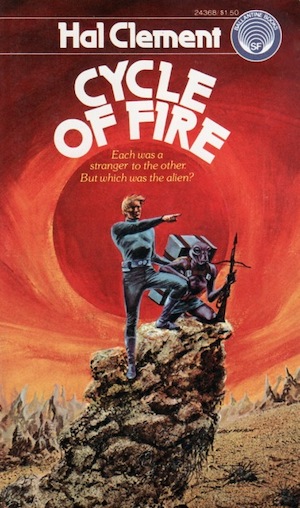
Precisely how ancient red dwarf Theer came to orbit much younger, far more massive Alcyone is unclear. The consequences, however, are obvious. Theer’s habitable world Abyormen cycles between comfortable temperate conditions and overheated and wet greenhouse conditions. Abyormen’s life has adapted in ways Terrestrials would find astounding.
Providentially for castaway Nils Kruger, inadvertently abandoned on Abyormen by fellow crewpersons, Abyormen is in the temperate part of its cycle. Even better, he encounters native Dar Lang Ahn, in whose company he explores an alien world Nils is unlikely to leave soon. Thus, he gains knowledge of just how Abyormen’s life has adapted to its periodic baking. To his distress, he realizes that these adaptations could make the likeable aliens a threat to humanity.
***
The Flying Sorcerers by David Gerrold and Larry Niven (1971)
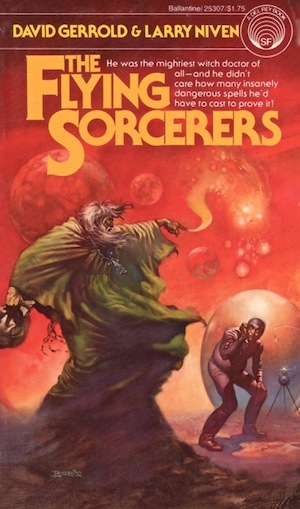
The setting of this novel is little inhibited by plausible orbital mechanics. The unnamed world follows a figure-eight path around red giant Virn and white dwarf Ouells. Its climate is driven by orbital position. The natives of the world have yet to discover science, but their purported magic (actually pragmatic ritual and rules of thumb) allows them to survive the chaotically evolving conditions. This gives Shoogar, a village magician, a very lofty status indeed.
Shoogar’s pleasant life bullying his fellow villagers is disrupted by the appearance of Purple, an oddly hairless visitor from someplace other whose attempts to study the local culture only manage to disrupt it. Purple does not show Shoogar the respect that the magician deserves. Indeed, Purple claims that the powerful magic he, Purple, obviously commands is not magic at all! Offended beyond reason, Shoogar sets out to rid his world of this uninvited guest. Alas, the magician only succeeds in marooning the pesky scientist…
***
Fire Time by Poul Anderson (1974)
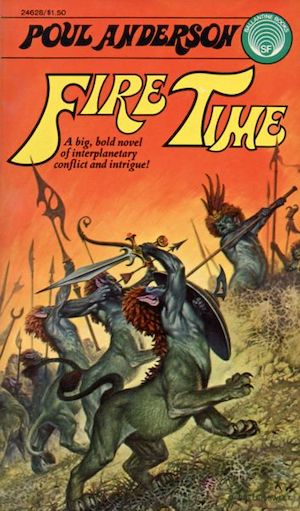
Earth-like Ishtar orbits sunlike Bel. Bel in turn is bound to Anu. More massive than Bel, Anu has evolved off the main sequence. What was a Sun-like star is now a red giant almost three hundred times as bright as Sol. When Anu is at its furthest distance away, some two hundred-plus AU, its luminosity matters little to Ishtar. When every thousand years Anu is only 40 AU from Ishtar, however, it adds an impressive twenty percent to the light falling on Ishtar, enough to make vast swaths of the planet uninhabitable.
As a consequence, civilization on Ishtar has been cyclic. When Anu is distant, civilizations thrive. When Anu is close, desperate legions fleeing climate change overwhelm more fortunate regions. It is just the way things are.
This time, however, aliens calling themselves humans have taken an interest in the planet. Perhaps the cycle can be broken with human aid—provided that a needless conflict between humans and another galactic race does not kneecap the human attempts to assist Ishtar before civilization falls again.
***
The Snow Queen by Joan D. Vinge (1980)
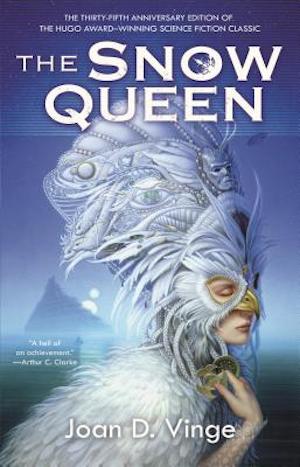
Tiamat’s twin stars orbit around a black hole. Their eccentric orbits shape the ocean world. As the binary stars approach the collapsar, they become more active, warming the terrestrial planet. But this increasing proximity to the black hole temporarily closes collapsar-based faster-than-light travel. Tiamat is periodically isolated from the other seven worlds of the Hegemony. These interregnums last for a whole century.
Tiamat is the only known source of a life-extending drug. The Hegemony is determined to keep the planet backward and easily dominated. Consequently, as Summer and isolation approach, the Hegemony sabotages all advanced technology on the world before handing the planet over to the technologically deficient Summer clans.
Tiamat’s Snow Queen Arienrhod is determined to end the cycle (not least because she will be ritually sacrificed in the handover ceremonies). The measures to which she resorts are extreme, but saving a world justifies extreme measures…doesn’t it?
***
Helliconia Spring by Brian Aldiss (1982)
![]()
Eight million years prior to the events of this novel, the G4V star Batalix encountered and was captured by Freyr, an A-type supergiant considerably brighter than Batalix. This transformed Batalix’ habitable world Helliconia from a comfortable icebox world to one where climate varies wildly, depending on where Batalix and Helliconia were in their eccentric, twenty-six-century orbit around the supergiant star. Bad news for the ancient phagors, shaped by evolution for a frozen world, but key to the rise of a very humanlike species on whom the narrative focuses.
Unsurprisingly for people who have read the title, Spring focuses on one particular spring, as the distance between Helliconia and Freyr shrinks and the planet warms. Temperatures soar and the planet is transformed! But on human timescales, the process is gradual, facilitating a generational epic in which the human population in the vicinity of the village Oldorando rebounds from ice age nadir, reaching towards heights of civilization not seen since the last interglacial millennia before. That is, if the phagor cannot prevent the upstarts from dominating the world.
***
No doubt you all have your own favourite novels set on planets with eccentric orbits and climates. Many of them are doubtless of far more recent vintage than the older works above. (How is it that something I bought when it first came out is now forty years old?) Comments are below.
(Can you believe I could not think of a footnote for this piece?)
In the words of Wikipedia editor TexasAndroid, prolific book reviewer and perennial Darwin Award nominee James Davis Nicoll is of “questionable notability.” His work has appeared in Publishers Weekly and Romantic Times as well as on his own websites, James Nicoll Reviews and the Aurora finalist Young People Read Old SFF (where he is assisted by editor Karen Lofstrom and web person Adrienne L. Travis). He is a four-time finalist for the Best Fan Writer Hugo Award and is surprisingly flammable.




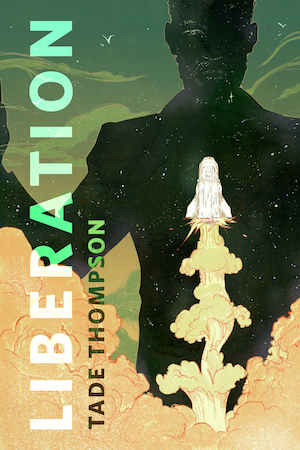






3 words:
Winter. Is. Coming.
“A Song of Ice and Fire” could refer to the swings between extreme summer and extreme winter…
In case people are wondering why I used Helliconia here but not in the essay immediately previous, they were written in the reverse order in which they went up.
No mention of Scadrial from Brandon Sanderson’s Mistborn series?
But I would not have mentioned the Sanderson because it’s fantasy but more importantly because I’ve not encountered that setting.
As I recall, Brunner’s The Crucible of Time has irregular climate shifts driven by interstellar debris.
On the multiple star system front, there’s Tran, from Pournelle’s Mercenaries series.
I don’t think Alan Dean Foster’s Tran-ky-ky counts, as it’s just in a plain old ice age.
Future Earth is badly done by in Niven’s A World Out of Time, but not in a cyclical manner nor from natural causes.
A Deepness in the Sky by Vernor Vinge features a world with a few hundred year cycle
I can’t resist mentioning Hal Clement’s “Cold Front” in which visiting humans offer their vast weather-predicting knowledge to natives of a planet, who must be laughing behind their hands at the stunning ignorance of the humans, who have missed one large factor in their calculations (eventually, the truth dawns on the humans)
A Deepness in the Sky by Vernor Vinge features a world with a few hundred year cycle
I can’t resist mentioning Hal Clement’s “Cold Front” in which visiting humans offer their vast weather-predicting knowledge to natives of a planet, who must be laughing behind their hands at the stunning ignorance of the humans, who have missed one large factor in their calculations (eventually, the truth dawns on the humans)
Three Body Problem by Liu Cixin.
I will always remember The Flying Sorcerers not for any aspect of its plot, but rather the joke hidden in Purple’s name. He introduces himself through a translator which renders his name as “As A Purple-Gray Color”–“As A Mauve.”
@@@@@ 1, Dr. Thanatos
3 words:
Winter. Is. Coming.
Winter is icummen in,
Lhude sing Goddamm,
Raineth drop and staineth slop,
And how the wind doth ramm!
Sing: Goddamm.
Skiddeth buss and sloppeth us,
And ague hath my ham.
Freezeth river, turneth liver,
Damn, you, sing Goddamm.
Goddamm, Goddamm, ’tis why I am, Goddamm,
So ‘gainst the winter’s balm.
Sing goddamm, damm, sing Goddamm,
Sing goddamm, sing goddamm, DAMN.
[Ezra Pound, Ancient Music, 1915]
No one remembers Ploor? E. E. (“Doc”) Smith would be sad.
David Gerrold and Larry Niven writing a book together just boggles the mind…
The Flying Sorcerers, was Gerrold’s first published novel and Niven’s fourth. As I recall, Gerrold’s Space Skimmer used the distinctive hyperdrive from Niven’s Known Space, although the setting was in all other respects very different.
I’m not talking about their professional convergences or tangential involvements like ST:AS.
Much like Fire Time, H. Beam Piper’s story, Oomphel in the Sky, has a native population that does magic to try and avoid the effects of extreme climate shifts. As expected in a Piper story, the leftist sociologists are incorrect about how to get the natives to listen; but luckily, there are profit-seeking Terrans who get things done.
I haven’t re-read it lately, but I believe that the Martians in Omnilingual died off due to climate change.
@12: If I recall correctly, Niven and Pratchett considered writing a book together – it didn’t happen, but the Niven half became “Rainbow Mars”, I think.
Love to see The Snow Queen mentioned. I find it mind-boggling that the book is so forgotten these days.
Never going to pass up an opportunity to recommend Jasper Fforde’s Early Riser. The planet is a version of Earth, of Wales really, an Earth so cold that humans hibernate.
@@@@@AndyLove @@@@@1: thank you for your recommendation of “Cold Front”. It’s on the web in its entirety. The plot, on the technical level and on the social level … I can’t think of something non-spoilery to write about it, except so right and so very very wrong.
No doubt there’s extremes on the world of Freeze-Bake
11, fcoulter
No one remembers Ploor? E. E. (“Doc”) Smith would be sad.
His grasp on weather was sometimes a little shaky, as in the case of Trenco, where the seas evaporated with hurricane force at dawn and condensed with torrential rain storms and lightning at night. Randall Garrett’s parody Backstage Lensman pointed out that if Trenco’s atmosphere vaporised and condensed as readily as he described, there should be little or no weather change:
With compounds of such low latent heat, the energy transfer is almost nil. Theoretically, the hot days should evaporate that liquid as quietly and gently as a ghost evaporates in a spotlight, and during the night it should condense as softly as dew from heaven falling upon the place beneath. Thermodynamically, the planet Trenco should be about as turbulent as a goldfish bowl…
The excellent and sadly little known Lear’s Daughters (originally published as a duology) by Marjorie Kellogg Bradley and William Rossow is about a planet whose dollar system is travelling through the coal sack nebula and experiencing climate extremes mitigated by the two goddesses (or are they?) of the indigenous populations. Highly recommended.
@19: Glad you liked it.
How about Stations of the Tide, by Michael Swanwick, where the continents are periodically drowned? “Every 200 years the planet floods and humans must leave until Miranda’s continents are reborn.” I don’t remember what the “scientific” explanation of this phenomenon was, if the book gave one.
Hello Summer, Goodbye by Michael Coney
Le Guin’s Planet of Exile
@Peter1742 Loved Stations of the Tide. But I don’t think it was climate change so much as an extreme cycle. The indigenous life had adapted to the tid, and evolution of that sort takes a while.
@9,
That wasn’t the only part of the joke. He was described as pudgy, and the cover art was suggestive of Asimov with the bushy sideburns. And at the reveal he says “how ironic that I should be involved in a bilingual pun.” Pure Asimov!
@@@@@ 28, Dr. Thanatos:
That wasn’t the only part of the joke. He was described as pudgy, and the cover art was suggestive of Asimov with the bushy sideburns. And at the reveal he says “how ironic that I should be involved in a bilingual pun.” Pure Asimov!
My favorite pun is trilingual and involves a single word.
Would Pern qualify, d’ye think?